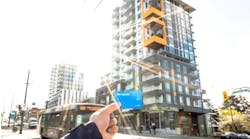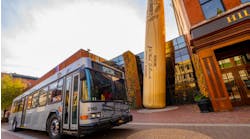Across cityscapes that are increasingly overwhelmed by advertising and product “branding” (think central places like Times Square, Dundas Square, Trafalgar Square, Shibuya), public transit brands are often overlooked as they zoom past windshields and pedestrians, but in the past few years such brands have become a favorite topic of debate for designers, architects, transportation planners, urban managers and civic leaders. Transit branding is a highly specialized sub-sector of the broader trend of place branding in which municipalities (usually medium to large sized cities) employ corporate-style branding methods to highlight desirable or unique traits in efforts to attract new residents, recruit new businesses, capitalize on natural resources, and increase revenue from tourism. The efficacy of place branding is debatable, particularly whether the expenditure of public money matches the return on investment; moreover few objective or reliable metrics exist to validate claims made by proponents of place branding.
The efficacy and return on investment for public transit brands are, in comparison, relatively straightforward to infer by using a number of widely accepted criteria.
The branding successes of multi-million dollar international corporations (such as Apple, Coke, Nike) has led to an ultra-allegiant, nearly cult-like, brand-centered fundamentalism among consumers. This allegiance is at the root of what market researchers commonly refer to as “brand equity.” The power of a well-cultivated brand has not gone unnoticed by government officials and has heavily influenced the manner by which place brands have taken shape. However, there is one critical difference between corporate-type brands and place brands: building brand equity requires a sustained investment, as well as constant attention and grooming. Often cash-strapped municipal governments do not have surplus budget to invest in the development or maintenance required to sustain a place brand. However, perhaps the investment in branding a city need not be as significant as with corporate counterparts. In the contemporary guerilla-branding climate, the branding potential of existing transit networks is often squandered. Because transit networks are integral to the urban fabric, they are often overlooked as a potential canvas for branding a cityscape. Compared to corporate brands, transit brands are far less taxing on the public purse, are typically less aesthetically-oriented, and are not as aggressively marketed. However, transit brands are potent. Examples include the vehicles, stations, signage, and maps of the Boston “T”, the Chicago “El”, Toronto streetcars, San Francisco cablecars, Paris Metro, Santiago yellow buses, New York Subway, Portland streetcar, the Seattle Monorail, and London Roadmaster (double-decker) buses. These transit brands are significantly more identifiable and readily recognizable in person, in advertisements, on television and in film than city-based place branding efforts that range in sophistication, from relatively simple (Miami-Dade, Detroit NeXT) to pragmatic (Cathedral City, Calif.) to more complex and broad-reaching (LondonOne), to abject failures (Anchorage Big Wild Life). In comparison, transit brands deliver a much greater saturation for the investment, or in colloquial terms: they pack a significant “bang for the buck.”
Outside major urban centers, particularly in North America, the overall image of bus transit is pretty sore. Plagued by operating inefficiencies, financial woes, old equipment, and infrequent service, public transit has been a distant (and often desperate) last choice for travel for many.
However, as gas prices continue to rise, and as consumer awareness of the deleterious effects of a car-dependent culture continues to broaden, public transit is receiving renewed attention as an environmentally sound way to move people — not cars — around cities and promote personal health by increasing physical activity.
Bus rapid transit (BRT) is a reconceptualized form of traditional city bus service. BRT typically includes: hi-tech, ultra-comfortable vehicles, which are usually brand new or souped-up rubber-tired buses; fewer stations (meaning fewer stops and faster travel speeds); connections between important regional destinations; as well as enhanced passenger comfort and convenience, including flexible fare structures, technology-friendly real-time arrival and departure information available on PDAs and mobile phones, and wireless (Wi-Fi) hotspots near stations. Undoubtedly, from a consumer perspective, BRT is a substantial upgrade from traditional (slow, polluting, unreliable) bus service.
Marketing research demonstrates a broad spectrum of rider “wants” from speed to comfort to luxury. This same data shows a high degree of rider satisfaction across a broad spectrum of desirable BRT amenities that include simple upgrades such as reliable, expedient service, plush well-appointed vehicle interiors, on-board “quiet” zones, and free coffee and refreshments. Many of these “extra” amenities are somewhat foreign to public transit managers. Marketing and design professionals involved with branding BRT systems often take a cue from successful airline branding efforts like JetBlue and Virgin: consistency of visual message, constancy in the deployment of the visual message across media, and completeness of the traveler “experience” from beginning to end of the journey. These brand “touchpoints” differentiate and highlight the service qualities that make a difference in a competitive field.
BRT integrates readily into a variety of urban and suburban settings and does not necessarily require significant construction or infrastructure changes. For this reason, BRT can be implemented incrementally, making it a realistic and attractive option for resource-strapped transit agencies. For example, BRT requires only about one-quarter of the up-front costs relative to light rail. BRT also provides an opportunity for alternative streams of funding. Public art is often integrated into a BRT system, helping to make station stops and the journey more interesting and engaging. Undoubtedly the lower capital cost of BRT strengthens its appeal, and the emergence of BRT is viewed by many in the transit industry as a unique opportunity to change negative perceptions regarding public transit, particularly in North America, but perhaps abroad as well.
Though often managed by a parent transit agency, BRT systems typically establish distinct identities which communicate different brand messages, among those most popular: “fast,” “new,” “convenient,” “eco-friendly,” transportation “value.” A number of transit agencies have in fact opted to use the surfaces on busses and near stations, as well as those along BRT routes (that would otherwise be sold to advertisers) to highlight the desirable features of high-speed bus service. This space now emphasizes unique aspects of the ride and helps to reinforce the brand message and BRT identity throughout a journey. The result is fewer bus wraps, more full-bus color painting, greater attention to design detail, prominently featured logos, usable graphics, and up-to-the-minute travel information, as well as better integration with other types of transportation as inter-modality is a feature of many BRT services.
The new approach for public transit is working. The branding success of the BRT MetroRapid line in Los Angeles has translated into a sharp increase in ridership. Users of the MetroRapid BRT are made to feel as if they are part of “a club” — one formulated for many out of choice, not necessity. Thanks to a steady influx of vehicles, stations, routes, and reduced travel times, ridership continues to surge. The Los Angeles MTA has taken notice. It has begun to decrease the amount of advertising space across the extensive Southern California network, and has opted to use this space instead for branding and advertising the benefits of BRT. The MTA has also begun to use similar branding strategies on non-BRT transit lines, such as the Metro Local.
Similarly, branding strategy played a significant role in the new VIVA BRT line in North York (north of Toronto, Ontario). Branding expenditures for VIVA accounted for a significant portion of the overall budget, and the outcomes have been similar to those in Los Angeles: increased ridership and an enhanced travel experience. When deployed consistently, the return on investment for transit branding can be significant, and as the peak in fuel prices prompts people to seek other, less expensive transportation options, branding can help to change public perceptions about public transit, and by extension about the overall collective mindset of a particular city.
This change in perception will inevitably entice many to consider public transit as an alternative to private cars. Over time, this change in consciousness can translate directly into increased reach of transit services, reduced commute times, less pollution and congestion, lower municipal road maintenance and infrastructure costs, and increased housing and employment densities, even away from the urban core.
In the near future, look for new BRT systems in North American cities — but, before that, look for transit branding with new names that connote fast and connected service (like MetroRapid in Los Angeles or B-Line in Vancouver), hot and premium colors that connote style (SilverLine in Boston), and logos that suggest energy (Viva in Toronto) or luxury (Lymmo in Orlando).
Branding BRT will provide an opportunity for riders to re-examine public transportation, and will help “sell” an image of fast, convenient, stylish, economical and environmentally friendly public transit, and suggest that North American cities and regions are, at long last, headed in the right direction.
Alex Bitterman, MArch., PhD., is associate professor in the School of Design at the Rochester Institute of Technology, Rochester, N.Y. A designer and architect, he is an internationally respected expert in place branding, corporate identity, and identity systems, and much of his research focuses on the efficacy of place branding and the accessibility of identity systems for people with physical, cognitive, cultural, or situational impairments. Bitterman is the editor-in-chief of Multi: the journal of diversity and plurality in design, and is the author of several books and one textbook.
Daniel B. Hess, PhD, is associate professor in the Department of Urban and Regional Planning at the University at Buffalo, State University of New York. He earned a doctoral degree in urban planning from the University of California, Los Angeles, where he was awarded a Dwight D. Eisenhower Fellowship for Transportation Research from the U.S. Federal Highway Administration. The author of numerous articles in leading urban planning and transportation journals, Hess has published research about best practices for increasing transit ridership, the role of transportation access in employment, and the relationship of land use planning and urban design to delivery of transportation services.


